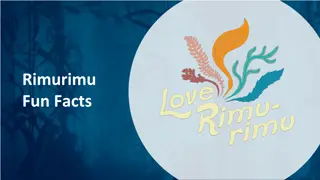Characteristics of Phaeophyta - Brown Algae (Seaweeds)
Phaeophyta, also known as brown algae or seaweeds, exhibit unique characteristics including cellulose fibers with Alginic acid, food reserves like laminarin and mannitol, and a life cycle consisting of both haploid and diploid stages. They possess photosynthetic pigments giving them their brown color, and can adapt to various marine environments. Kelps, belonging to order Laminarales, are a notable group within Phaeophyta. Some members develop air bladders for floating and light harvesting, but can also be a nuisance in aquariums. Brown algae typically have three parts comprising holdfasts, stipes, and blades. Classification includes three classes based on life cycles of species.
Download Presentation

Please find below an Image/Link to download the presentation.
The content on the website is provided AS IS for your information and personal use only. It may not be sold, licensed, or shared on other websites without obtaining consent from the author. Download presentation by click this link. If you encounter any issues during the download, it is possible that the publisher has removed the file from their server.
E N D
Presentation Transcript
Division Phaeophyta -Brown algae (Seaweeds) The main characteristics of Phaeophyta are: 1- Cell construction: cellulose fibers bound with Alginic acid , Fucoidan form cell walls. 2- Food reserves: laminarin , mannitol. 3- Reproduction of this algae takes place by both sexual and asexual means. Higher phaeophyta have life cycle consisting of both haploid , diploid stages and alternation of generation. The thallus representing haploid stage and diploid stage may be similar (isomorphic) or different (hreteromorphic). 4- Photosynthetic pigments: chlorophyll a and c, beta carotene, Dinoxanthin ,violaxanthin, and Fucoxanthin. These pigments give brown algae color and Fucoxanthin pigment are dominant
5-phaeophyta(Sea weeds) belonging to order Laminarales are called kelps can reach to about 70 meters in length. Kelps are the only algae with a significant internal tissue differentiation. Kelp grows in "underwater forests" in shallow oceans, Though true conductive tissues , xylem and phloem are absent. 6-Brown Algal Tissue Differentiation: Epidermis, Cortex and Medulla
6- They can adapt to a wide marine environment; tidal, intertidal and deep zones. 8- Some members of phaeophyta have Containing bladders or airbags, meant for floating photosynthetic parts on or near the water surface for harvesting light.
9- They often cause nuisance to aquarium environment by developing brown patches on any exposed surfaces such as rocks or gravel. 10- Morphology Members of this division typically have three parts. They are A] Holdfast which attachment the alga to the substrate B] Stipe which is stem-like C] Laminae (blades) which are leaf-like Brown algae
Division of brown algae are classified into three classes depending on the type of life cycles of the species 1-Class : Isogenerate 2-Class: Hetrogenerate 3-Class: Cyclosporea
1-Class :Isogenrate -Order: Ectocarpales Ectocarpales is a very large order in the brown algae includes families with pseudoparenchymatous or true parenchymatous tissue. Asexual reproduction by Zoospores (motiles). Monospores,Tetraspores ,nautral spores(non-motiles). Sexual reproduction by Isogamous or anisogamous, and alternation of generation. Differentiation observed in a small number of species where they differentiate the two regions cortex and medulla .
Filamentous algae are composed of cells that divide along a single plane, allowing only elongation to form filaments of one or more rows of cells. Algae that can divide in two planes can form sheet-like thalli or bodies.
Ectocarpus is a genus of filamentous brown alga (model organism for the genome of multicellularity). Thallus filamentous, much branched, with most branches tapering gradually to a false hair, Growth diffuse, Cells with several elongate, chloroplast ribbon-like, and each with several pyrenoids. Asexual reproduction: by biflagellate zoospores produced in plurilocular sporangia. --Sporophyte and gametophyte appear morphologically similar(Isomorphic) . the Sporophyte carries both plurilocular and unilocular sporangia the Gametophyte carries only plurilocular gametangia Unilocular sporangia develop on haploid plant. Plurilocular sporangia developed on diploid plant
Life cycle of Ectocarpus siliculosus Diploid Sporophytes produce meiospores (by meiosis) in unilocular sporangia (UL). Meiospores grow into male or female gametophytes (dioecism). Gametophytes produce gametes in plurilocular gametangia (PL). Fusion of gametes produces a zygote that grows into a diploid sporophyte, completing the sexual cycle. Unfused gametes may grow parthenogenetically and form a parthenosporophyte, which is indistinguishable from the diploid sporophyte. Both parthenosporophytes can reproduce themselves asexually by the production of mitospores in plurilocular sporangia. sporophytes and
2-Class:Hetrogenerate Order: Laminarales Kelp or Rock weed" General characteristics 1- individuals with a macroscopic sporophyte generation diploid and a microscopic gametophyte generation haploid. 2- The sporophytes are large with a holdfast, stipe, and one or more blade or blades. 3- The stipe is usually cylindrical. It is either simple or branched.
4-Growth of the sporophyte occurs at an intercalary growth. 5- The sporangia are usually cylindrical, always unilocular, and always found in sori. The sori are borne on the blades. 6- Gametophytes are filamentous. The Antheridia of the male gametophyte produce antherozoid. The Oogonia of the female gametophyte produces a single egg. 7-The parenchymatous thalli are generally covered with a mucilage layer.
(Notes: The haploid phase begins when the mature organism releases many spores, which then germinate to become male or female gametophytes. Sexual reproduction then results in the beginning of the diploid sporophyte stage, which will develop into a mature individual. Laminaria sp
Laminaria sp. 1-Exhibits a life cycle called alternation of generations 2- The Sporophyte is diploid; the gametophyte is haploid 3-The gametophyte produces haploid gametes by mitosis 4-The gametes unite by fertilization to form a zygote that develops into a sporophyte 5-The sporophyte produces haploid spores by meiosis 6-The spores grow up into male or female gametophytes 7-The main form is the sporophyte, the gametophytes are short, branched filaments the two generations are heteromorphic
Class:cyclosporea Order: Fucales General characteristics seaweed construction: a holdfast, stipe and lamina. The lamina is often much branched and have may bladders. Growth is by division of the apical cells. Sexual reproduction ,They are Oogamous where there is fusion between the small male gamete and the large female gamete. Tissue differentiation observed in the structure of the lamina.
Fucus vesiculosus flattened thallus and a dichotomous branching pattern. Small cavities called Cryptostomates are scattered on the surface. Cryptostomates have sterile hairs(paraphysis) that function in the uptake of nutrients from the seawater. F. vesiculosus pairs of air bladders along its thallus. These bladders provide buoyancy.
Vegetative structure The plant body is a has three major regions: 1. Hapteron or holdfast attaches the plant to the rock. 2. Stipe is a flexible stalk that joins the hapteron to the rest of the plant. 3. Frond is a flat, much branched leathery structure.
Reproduction Asexual reproduction This is not very common. The only method of asexual reproduction shown by fucus is Fragmentation when parts which break away become established as new plants. Sexual reproduction This is the usual method of reproduction for the fucus vesiculosus is dioecious ( separate male and female plants). 1. The tips of the fronds enlarge to form receptacles. Each receptacle contains conceptacles. 2. The gametes are formed in the conceptacles. 3. Meiosis in the antheridium followed by four mitosis produce sixty four haploid sperm cells.
4. Meiosis in the Oogonium followed by one mitosis produces eight haploid egg cells . 5. When the tide is out the plant loses water, which causes it to shrink. The shrinking receptacles squeeze mucilage out of the conceptacles through the ostiole. 6. The mucilage carries the mature Oogonia and antheridia at the surface of the receptacles. The mucilage is secreted by the paraphysis. 7. When the tide comes in, the mucilage is washed away, the antheridia and Oogonia rupture releasing the gametes into the open sea.
8. The egg cells being more dense than water sink to the bottom. The sperm cells swim and are attracted to the non- motile eggs by a chemical substance (chemotaxis : response to chemical stimulation). Many sperm may surround each egg. 9. One sperm enters and fertilizes the egg. This results in a diploid zygote being formed. 10. The zygote germinates immediately. By mitosis and differentiation the zygote develops into a mature diploid plant.
Adaptive of the fucus Structural adaptions - The holdfast anchors it to the rock. - The air bladders increase the buoyancy of the plant. - Mucilage covers the plant which helps prevent desiccation when the tide is low. - The thallus is tough and leathery which allows it to withstand wave action. - The stipe and frond are flexible which allows it to bend with the waves The presence of the brown pigment fucoxanthin allows the absorption of wavelengths of light that penetrate the water.
Phaeophyta uses marine seaweeds of phaeophyta are used for the extraction of Iodine , potash and alginic acid is used for deriving alginate, a major colloidal gel used emulsifier in applications such as printing, toothpastes, soaps, ice creams, meat preservation In agricultural or horticultural sprays. as a food source or food supplements. alginic acid. This many industrial
Kelps uses 1-The primary known constituents of Kelp include iodine, potassium, bromine, mucopolysaccharides, mannitol, alginic acid, kainic acid, laminine, histamine, zeaxanthin, protein, and Vitamins B-2 & C. 2-The seaweed Kelp (Fucus vesiculosis) is an excellent source of minerals from the sea, particularly Iodine which is very important for the thyroid gland to function properly. 3-Kelp is known for the following properties: antibacterial, antioxidant, diuretic, expectorant and nutritive, and is generally available in the forms of tea and capsules. 4-kelp have a link to a lower breast cancer rate; less obesity, heart disease, rheumatism, arthritis; lower blood pressure; less thyroid disease.























